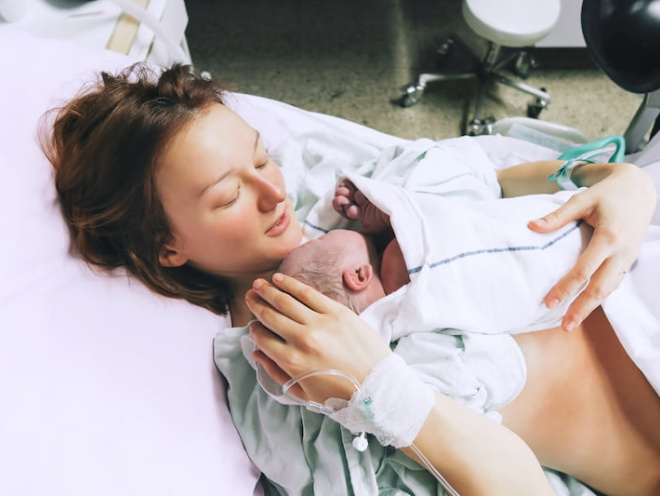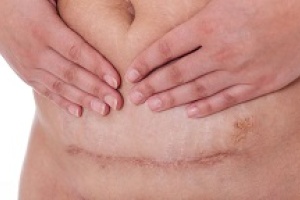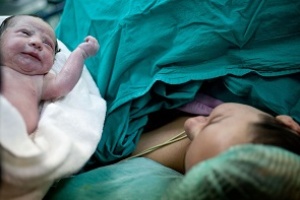Knowing what happens during a caesarean and immediately after can help you feel more prepared.
Here, we explain what happens before the operation, the difference between planned and unplanned caesareans, the anaesthetic used, and what happens afterwards.
What is a caesarean birth?
Caesarean birth is when a baby is born by abdominal surgery. Around a third of babies in the UK are born by caesarean (NHS Digital, 2021). Some are planned, while others are unplanned caesareans.
To find about more about when a planned or unplanned caesarean may be offered and the different things you might want to consider, read our article.
Planning for a caesarean birth
A planned or ‘elective’ caesarean usually takes place after 39 weeks of pregnancy, when a baby’s lungs are developed, to reduce the chances of your baby having any breathing problems immediately after birth (NICE, 2021). However, there may still be health factors to consider that will mean your midwife or doctor may suggest a planned birth earlier than 39 weeks (NICE, 2021).
If you are carrying twins or triplets, your doctor or midwife will discuss your particular circumstances, and the type and timing of the birth with you. This may include a planned caesarean as early as 32 weeks for the most complicated situations (NICE, 2019).
What will happen before my planned caesarean?
If you are planning to have a caesarean birth, you will have the opportunity to discuss your decision and birth preferences with your midwife and doctor.
You will be offered an appointment about a week before the planned date to discuss the procedure and you will be given medication to take before the operation. This could include antibiotics, anti-sickness medication, or anti-acid medication (NHS, 2019a).
You will also be offered a blood test to check for anemia and determine your blood group (NICE, 2019, 2021a).
You will be asked to sign a written consent form. The information should always be presented to you in a way which you can understand (NICE, 2021; RCOG, 2015). This is your chance to ask any questions, and have time to consider the answers, before you sign the consent form (NHS, 2019a).
You’ll be given a time to arrive at hospital and asked not to eat for a few hours before the surgery, although isotonic drinks may be recommended (NHS, 2019a; NICE, 2021). Surgery may not take place for several hours after your arrival time, depending on how many other planned and unplanned caesareans are being performed that day. Some parents take things to keep themselves entertained in this time, and this is also an opportunity to ask any more questions you might have.
When you arrive at hospital, a midwife will check you have taken the medication given to you at your pre-operative appointment and may recommend pressure stockings to reduce the risk of deep vein thrombosis and pulmonary embolism (when an artery in the lungs is blocked by a blood clot that has travelled from elsewhere in the body).
You’ll often meet the anesthetist first to discuss your options. A regional (spinal) anesthetic is most common (OAA, 2022) but some caesareans are performed under general anesthetic.
What happens just before I go into theatre?
You will be given a gown to put on for theatre, and a name band for your wrist or ankle. Your birth partner will be invited to change into theatre scrubs as well.
Once in theatre, your blood pressure, pulse and temperature will be checked, and your baby’s heartbeat will be monitored. You will be asked to confirm your name and date of birth (OAA, 2022).
Your birth partner may be directed where to sit and asked to avoid certain areas of the room to minimise the chance of infections (OAA, 2022).
Regional (spinal) anesthetic is most commonly used during caesarean birth. You will be invited to sit or lie on your side, curling your back. The anesthetist will spray the area with a sterilizing solution before administering a local anesthetic to numb the lower back. The spinal anesthetic is then administered, but it may take a few minutes to get it in the right place.
Some people describe the sensation as tingly or like a small electric shock, and as the drug takes effect the legs and lower body begin to feel very heavy and warm. The anesthetist will be monitoring how you are feeling and can provide treatment if you feel sick or dizzy (OAA, 2022).
Once the anaesthetic has been administered in theatre, a catheter will be inserted into your bladder to drain urine away and a drip will be put into your arm to provide fluids and any medication, such as antibiotics.
The incision for your caesarean birth will be made around the area where pubic hair grows. If there is any hair in this area, it will be shaved off before the birth (NHS, 2019; OAA, 2022). It is not recommended to do this yourself in advance, as research shows this leads to a higher chance of wound infection (Ng et al, 2013).
Caesarean under general anaesthetic
Around 9 in 100 caesarean births are performed under general anaesthetic (Bamber et al, 2020). Some women chose this due to an extreme fear of needles (OAA, 2022) while medical reasons could include allergies, clotting issues, or spinal problems (OAA, 2022; NHS, 2019a).
A general anaesthetic might also be used if your baby needs to be born quickly (OAA, 2022).
During a general anaesthetic your birth partner may not be allowed to be present in the operating theatre (OAA, 2022). They can wait in recovery and will be able to look after the baby and have skin to skin contact while you come out of theatre. If your baby needs to be taken to special care for any reason, your birth partner may be invited to join them.
What happens during a caesarean?
The procedure is similar whether the caesarean is planned or unplanned.
Don’t be surprised if there are a lot of people in the operating theatre. Depending on the reason for your caesarean, staff might include:
- midwife(ves)
- two obstetricians
- a theatre nurse and an assistant
- an anaesthetist and an assistant
- paediatrician (a doctor specialising in children)
If you’re awake during the procedure, a screen is usually put up so you and your birth partner can’t see the operation. If you prefer, you can ask to have the screen lowered when your baby is being born.
Your birth preferences, like playing music in theatre, or silence so your voice is the first your baby hears, should be accommodated where possible.
During the procedure you will be slightly tilted on to your side and may be aware of the sounds of the instruments being moved around, and of the suction of fluids from around the baby. This is completely normal.
You shouldn’t feel any pain during the operation, but you might feel some pressure. You might also feel some mildly uncomfortable, rather than painful, sensations. Some women have said it feels like ‘having someone doing the washing-up in my tummy’. Generally, the anaesthetist will talk to you during the operation and give you more pain relief if you need it.
If you’ve had a general anaesthetic, you won’t be aware of anything until you’re awake. This will usually be in the recovery room rather than the operating theatre.
When will I meet my baby for the first time?
If you’re awake and your baby is well, you can cuddle and have skin-to-skin contact straight away. Your partner can also do this if you prefer.
You can also choose delayed or optimal cord clamping. Waiting to clamp the cord can provide the baby with a higher iron level after birth. If possible, it’s good to discuss your preferences with your obstetrician before your operation.
If you have a general anaesthetic and your baby is well, they might be given to your birth partner for skin-to-skin contact in another room near the operating theatre.
Sometimes you will be able to have assisted skin-to-skin contact in the operating theatre, even if you’re not awake. Your baby can be placed on your chest and supported by a midwife while your wound is stitched.
If your baby needs any help breathing, or has other problems, they may be taken to the special care baby unit (Labour Pains 2018).
Will happens if I need an unplanned caesarean?
An unplanned caesarean (sometimes called an emergency caesarean) takes place during labour, or before labour starts if an unexpected medical problem comes up.
If there are immediate concerns for you or your baby, an emergency caesarean will usually be performed within 20-30 minutes, although this only occurs in around 1 in 10 unplanned caesarean births (NICE, 2021; OAA, 2022).
If there are no immediate concerns, it could take up to 75 minutes from when the decision is made, and the preparation will be very similar to that of a planned caesarean (NICE, 2021). You will be asked to sign a written consent form, but in an emergency, verbal consent is sufficient (NICE, 2021; RCOG, 2015). Partners cannot sign the form instead of the woman, even if she is unconscious (Birthrights, No date).
If your caesarean is unplanned and you’ve already had an epidural during labour, this is usually topped up. Occasionally, an epidural alone is not sufficient, in which case other options include a combination epidural and spinal block, or a general anaesthetic (OAA, 2022).
What happens after a caesarean?
While you’re staying in hospital you will be given pain relief. You should also be able to have close contact with your baby and start breastfeeding, if you would like to – some people even start doing this in theatre or the recovery room. You should be offered infant feeding support as soon as possible after the birth of your baby.
You’ll be encouraged to get out of bed when you feel able to and to eat and drink as soon as you want to. You won’t be able to drive for a few weeks, so you will need to arrange transport home.
You should receive advice on looking after your wound at home, and on taking any painkillers you may need during the recovery period.
You can read more about other aspects of caesarean birth in some of our related articles.
This page was last reviewed in August 2022
Further information
Our support line offers practical and emotional support with feeding your baby and general enquiries for parents, members and volunteers: 0300 330 0700.
We also offer antenatal courses which are a great way to find out more about birth, labour and life with a new baby.
Make friends with other parents-to-be and new parents in your local area for support and friendship by seeing what NCT activities are happening nearby.
For statistics on your local hospital’s caesarean section rates, see which birth choice.
Andersson O, Hellström-Westas L, Domellof M (2016) Elective caesarean: does delay in cord clamping for 30 s ensure sufficient iron stores at 4 months of age? A historical cohort control study BMJ. Available at: https://doi.org/10.1136/bmjopen-2016-012995
Bamber et al (2020) Obstetric anaesthetic practice in the UK: a descriptive analysis of the National Obstetric Anaesthetic Database 2009-14. Available at: https://doi.org/10.1016/j.bja.2020.06.053
Birthrights (No date) Birth partners. Available at: https://www.birthrights.org.uk/factsheets/birth-partners [Accessed 15 Sep 22]
Ng W, Alexander D, Kerr B, Ho MF, Amato M, Katz K (2013) A hairy tale: successful patient education strategies to reduce prehospital hair removal by patients undergoing elective caesarean section, Journal of Hospital Infection, 83 (1) Pp 64-67, Available from: https://doi.org/10.1016/j.jhin.2012.09.013
NHS. (2019a) Caesarean section – What happens. https://www.nhs.uk/conditions/caesarean-section/what-happens/ [Accessed 25th April 2022]
NHS (2019b) Caesarean section – Recovery. Available at: https://www.nhs.uk/conditions/caesarean-section/recovery/ [Accessed 25th April 2022]
NHS (2021) NHS Maternity Statistics, England - 2020-21. Available at: https://digital.nhs.uk/data-and-information/publications/statistical/nh… [Accessed 25th April 2022]
NICE (2019) Twin and Triplet Pregnancy [NG137]. Available from: https://www.nice.org.uk/guidance/ng137/resources/twin-and-triplet-pregnancy-pdf-66141724389829. [Accessed 25th April 2022]
NICE.(2021) Caesarean birth [NG192]. Available from: https://www.nice.org.uk/guidance/ng192 [Accessed15 Sep 2022]
OAA (2022) FAQs your anaesthetic for caesarean section. Available from: http://www.labourpains.com/FAQ_CSection [Accessed 25th April 2022]
RCOG (2015) Obtaining Valid Consent. Available at: https://www.rcog.org.uk/guidance/browse-all-guidance/clinical-governance-advice/obtaining-valid-consent-clinical-governance-advice-no-6/ [Accessed 25th April 2022]








